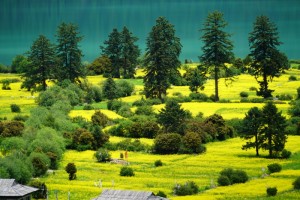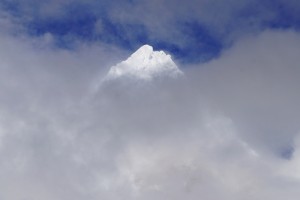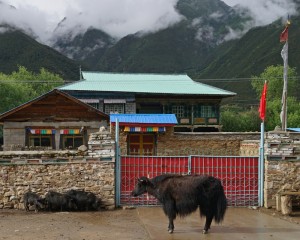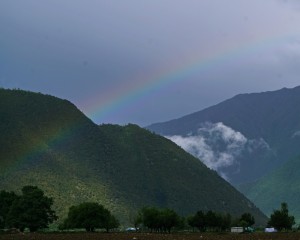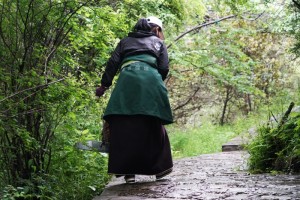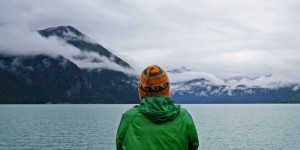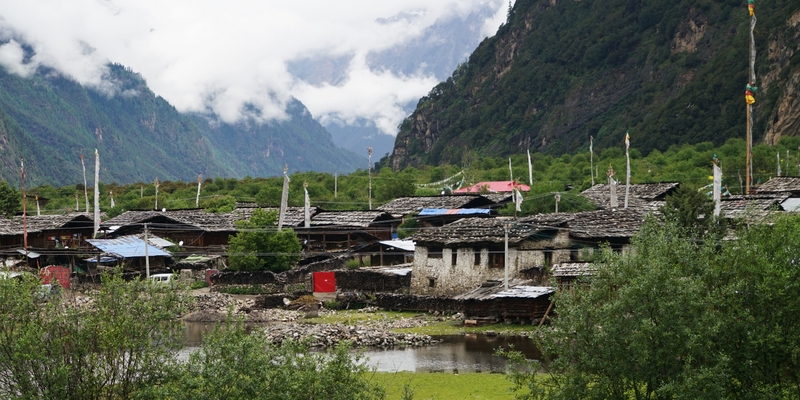Part 3: Lhasa – Nyingchi – Yarlung Zangbo Grand Canyon June 19 – 22
June 19 Monday: Lhasa
It’s always great after a good night’s sleep. After breakfast, I walked to Norbulingka 羅布林卡, the summer palace of Dalai Lama, near Lhasa Hotel. I visited it in 2011 but would like to take a stroll in the beautiful garden. This is impossible without paying a full but reduced entrance fee of RMB30. I had to drop the idea. I crossed the road to reach at the Museum of Tibet. But it has been closed for renovation since 2016. I returned to the hotel getting myself ready for a visit to the Potala Palace with Kylie and Kai. 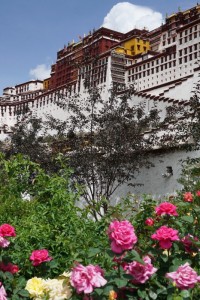
Potala Palace布達拉宮
Tradition has it that the three main hills of Lhasa represent the “Three Protectors of Tibet”. Chokpori 药藥王山is the soul-mountain of Vajrapani金剛手菩薩,Pongwari that of Manjusri and Marpori, the hill on which the Potala stands, represent Avalokiteśvara. In 637, Songstan Gampo built his palace on Marpori, the mythical abode of the bodhisattva Avalokiteśvara. In 1645, the 5th Dalai Lama began construction when one of his spiritual advisers, Konchog Chophel who died the following year, pointed out that the site was ideal as a seat of government as it is between the Drepung and Sera monasteries and the old city of Lhasa.
The present building measuring 400m east-west and 350m north-south, with sloping stone walls averaging 3m thick and 5m thick at the base. The palace soars 117m on top of Marpori, the “Red Hill” and rises over 300m in total above the valley floor. It occupies 13 stories and containing over 1,000 rooms, 10,000 shrines and about 200,000 statutes.
New procedures have been introduced since my first visit in 1990s. The number of visitors is now limited to over 2,000 a day (?) to this World Heritage Site. We first paid RMB 200 each to our agent and were told our scheduled entry was 12:40pm. We must be accompanied by a guide (RMB300) who picked us up at the hotel at 11:30am.
With our ticket, we entered the palace ground which was beautiful with roses in full blossom. Then we made our way walking slowly up the staircases that lead to the summit of the rock where the entrance to the palace is located. Our guide told us to buy another ticket for the palace. I paid a half price ticket (RMB100) with entry time at 12:40pm. As we could not take photos beyond here, we stopped for a long photo stop to the annoyance of our guide.
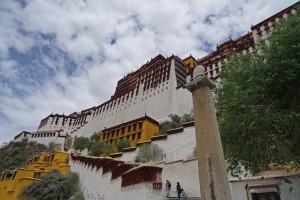 |
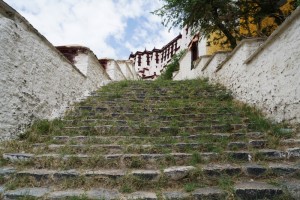 |
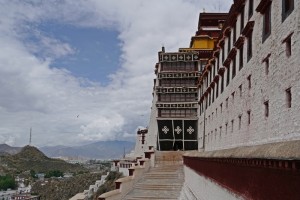 |
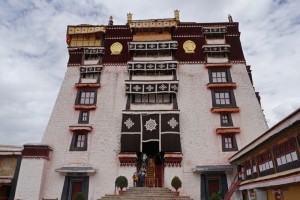 |
Visitors all follow the same route beginning at the White Palace which is the living quarters of Dalai Lama. The first White Palace was built in 1649 by the 5th Dalai Lama and was extended to its present size by the 13th Dalai Lama in the early 20th century. Inside the palace there are offices, the seminary and the printing house. We climbed countless flights of narrow staircases. I found the interior stuffy, dark, crowded and noisy.
After this, we passed a yellow-painted courtyard known as Deyanshar before entering the Red Palace that is devoted to religious study and prayer. It consists of a complicated layout with many different halls, chapels and libraries on different levels and a complex array of smaller galleries and winding passages. The Great West Hall with fine murals and special cloth from Bhutan wrapping the columns and pillars, is the central hall which consists of four great chapels.
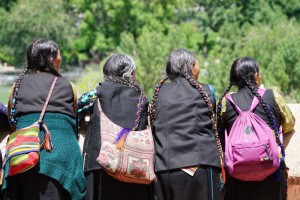 We followed our guide who did not say much about the history, architecture styles and culture. I have picked up more information from other guides. We wandered from one dark hall/chapel to another. Despite my reasonably good sense of direction, I could hardly figure out where I was heading. Though I paid a lot for the visit (i.e. RMB400 in total), I received no leaflet containing basic information such as the floor plan and route map. As no photo is allowed inside, I can only recall the main locations I have visited:-
We followed our guide who did not say much about the history, architecture styles and culture. I have picked up more information from other guides. We wandered from one dark hall/chapel to another. Despite my reasonably good sense of direction, I could hardly figure out where I was heading. Though I paid a lot for the visit (i.e. RMB400 in total), I received no leaflet containing basic information such as the floor plan and route map. As no photo is allowed inside, I can only recall the main locations I have visited:-
The Saint’s Chapel – an important shrine dating from the 7th century containing a small ancient jewel encrusted statue of Avalokiteśvara and two of his attendants.
The Dharma cave below the Saint’s Chapel is believed to be the place where Songstan Gampo studied Buddhism. I saw a couple of images of Songstan Gampo, his wives, his chief minister and Sambhota, the scholar who developed Tibetan writing.
The North Chapel centres on a crowned Sakyamuni Buddha on the left and the 5th Dalai Lama on the right. There is also a gold stupa tomb of the 11th Dalai Lama who died as a child.
The South Chapel is devoted to Padmasambhava, the 8th century Indian saint who subdued the demons of the Bon faith.
The East Chapel is dedicated to Tsongkhapa, founder of the Gelugpa.
The West Chapel contains five golden stupas for the 5th 12th,10th, and 13th Dalai Lama. The mummified body of the 5th Dalai Lama was contained in the largest one at the center standing at 14.85m.
By 2pm we came out from the other end of the Red Palace. Our guide was irritated and commented that we had been extremely slow. I did not enjoy the visit. First it is impossible to see this palace in an hour. I had no time to soak in the atmosphere and discover the place at all. Second, our guide is not knowledgeable and unhelpful. This is likely to be my last visit as there are too many steep staircases to climb up and down. Good-bye Potala Palace!
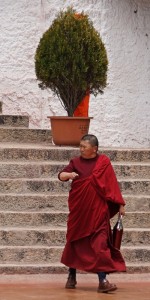 |
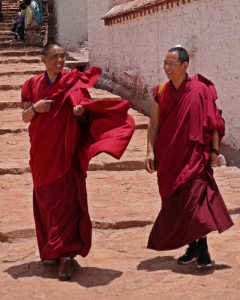 |
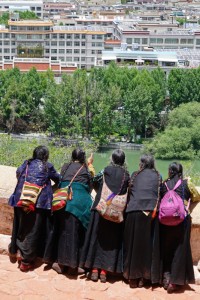 |
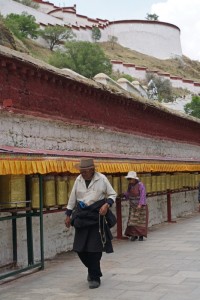 |
Zangpo waited for us at the car park and dropped us off at the West Gate with a viewing platform on the foothill of Chokpori. I took a few photos.
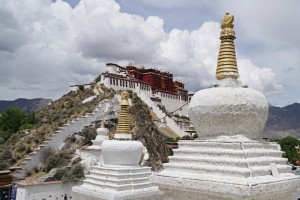 |
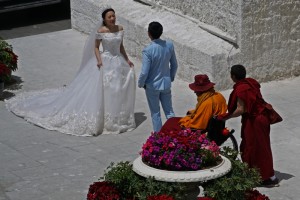 |
I have read about some old rock paintings in Chokpori 药王山摩崖石刻. We asked locals for directions and soon found our way to a rock cave located inside a small temple 鲁普岩寺.We paid RMB20 to enter. The amazing and vivid carving and paintingsare said to be done during during the reign of Songtsan Gampo by Nepalese artists. It was believed that Songtsan Gampo and his two sons had lived and medicated here.
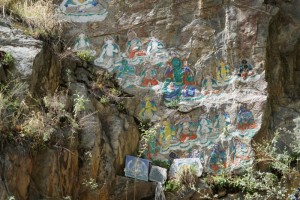 |
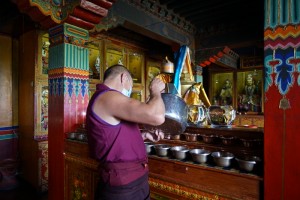 |
After the cave temple, Kylie and Kai took a taxi to the city centre while I went to search old rock painting on the other side of the hill. On the way, I had an interesting time strolling through a large market where I found live chickens and geese, fish, shrimp (big ones for RMB88 a catty), fresh vegetables, meat etc. I finally found the rock paintings next to a newly built temple and stupa 嘎珠尔塔. I watched a few pilgrims prostrating in front of a temple.
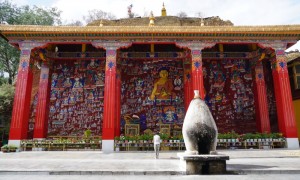 |
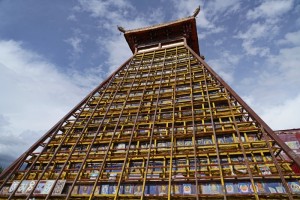 |
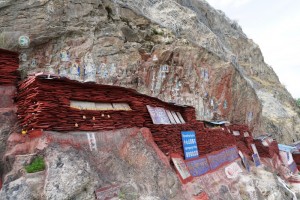 |
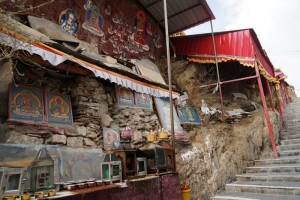 |
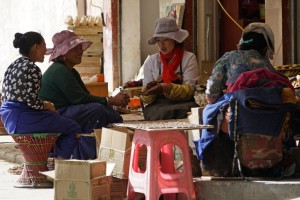 |
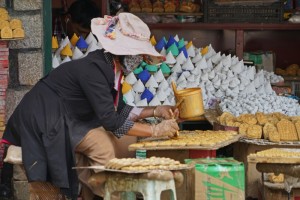 |
I returned to Lhasa Hotel taking a different route and knew Lhasa better after this visit. I got back just around 6pm feeling tired after having walked for almost seven hours!
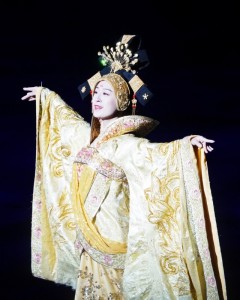 This evening, Kai, Kylie and I went to see a legendary opera “Princess Wencheng” 文成公主which is about a Tang Dynasty princess who married Songtsan Gampo. We bought our tickets through the hotel the night before (RMB480 pp for the ticket and transfer). We were picked up by a driver at 8:30pm (instead of 8pm as agreed). When we got our ticket, we discovered the printed price on the ticket was only RMB180. This means that we have been ripped off! Lesson to be learnt: one should book the ticket online or through an agent after shopping around for a good deal.
This evening, Kai, Kylie and I went to see a legendary opera “Princess Wencheng” 文成公主which is about a Tang Dynasty princess who married Songtsan Gampo. We bought our tickets through the hotel the night before (RMB480 pp for the ticket and transfer). We were picked up by a driver at 8:30pm (instead of 8pm as agreed). When we got our ticket, we discovered the printed price on the ticket was only RMB180. This means that we have been ripped off! Lesson to be learnt: one should book the ticket online or through an agent after shopping around for a good deal.
This is a spectacular performance. The venue built at a foothill on the other side of the Lhasa River, has probably the world’s largest stage (which is several kilometres long) with the surrounding mountains as backdrop. I guess over a thousand persons are involved in the performance and its production. This epic opera performance must be the largest single job provider in the tourism industry in Tibet.
The show started at 9:30pm and finished around 11:15pm. The setting is stunning with world-class stage design and management. The costumes are colourful. What I find most impressive is the scene-setting with a magnificent palace in Beijing appearing at the beginning of the performance. It changed into Potala Palace at the end of the show. A dozen of scenes indicated the arduous journey taken by the princess and her entourage from the present day Xian to Lhasa.
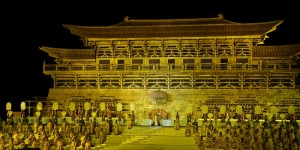 |
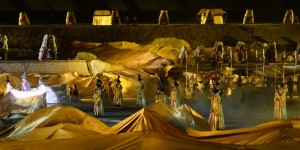 |
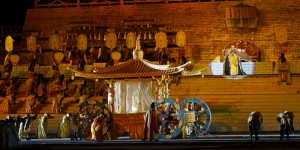 |
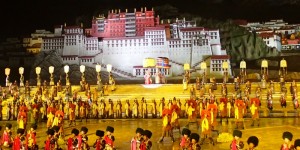 |
The weather was fine when the show started. Half way through, it started to rain and snow. By the time the winter scene came on with artificial snow flakes coming down, we had snow and sleet falling on our heads. For those with rain gear, they remained in their seats. Others rushed to seek shelter. The unpredictable weather had added realism to the show. I could feel the bitter cold and wet weather and suffering the he princess had to endure 1300 years ago!
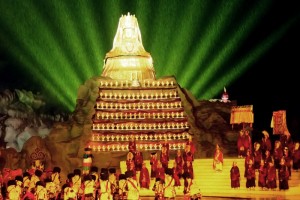 |
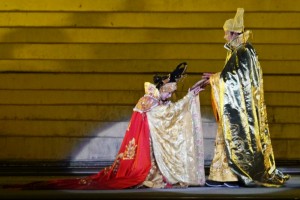 |
I had put on my rain pants and jacket primarily to keep the wind off. But they turned out to be very useful to keep me dry and warm. Kai also had a rain coat. But poor Kylie was wet and cold: she was still shivering when we were back in the hotel around midnight. I do not have a good ear and cannot comment on the singing. But the setting and the visual impacts of a performance are impressive and worth seeing.
7 Days from Lhasa to Bome June 20-26
June 20 Tuesday: Lhasa – Basomtso 巴松錯350km
After breakfast, we said good-bye to Kai, SK and Winnie and headed east with Zangpo who was able to be our driver till June 26 (But as he got another job later, he returned to Lhasa on June 25). Originally, he asked for RMB8800 and would take us to Medog. When he was told by a travel agent that we could not go to Medog, he agreed to take RMB800 less.
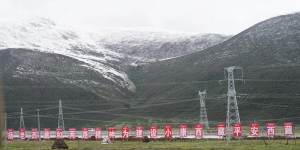 This’s the fourth time I travelled from Lhasa to Bome on National Highway 318. In 2011 the scenery along the road was charming with little traffic. But today, things have changed as a result of key infrastructural projects. First, the 400km-long highway between Lhasa and Nyingchi林芝mainly along the NiyangRiver, will soon be completed. The sections between Lhasa and Maizhokunghar墨竹工汴 (70km) and between Gongbo Gyamda 工布江達 and Nyingchi (125km) are already open to traffic. The remaining 200km of road would soon be completed. This new highway would shorten the journey time from six to four hours. Second, the first section of the Sichuan –Xizang Railway from Lhasa to Nyingchi 林芝began in 2015 and is expected to take roughly seven years to complete. As the two projects are in full swing, the countryside which was once tranquil is now littered with a dozen of construction sites. The serenity and pristine scenery along the Niyang River 尼洋河that I love so much has gone. Temporarily or forever? I wonder.
This’s the fourth time I travelled from Lhasa to Bome on National Highway 318. In 2011 the scenery along the road was charming with little traffic. But today, things have changed as a result of key infrastructural projects. First, the 400km-long highway between Lhasa and Nyingchi林芝mainly along the NiyangRiver, will soon be completed. The sections between Lhasa and Maizhokunghar墨竹工汴 (70km) and between Gongbo Gyamda 工布江達 and Nyingchi (125km) are already open to traffic. The remaining 200km of road would soon be completed. This new highway would shorten the journey time from six to four hours. Second, the first section of the Sichuan –Xizang Railway from Lhasa to Nyingchi 林芝began in 2015 and is expected to take roughly seven years to complete. As the two projects are in full swing, the countryside which was once tranquil is now littered with a dozen of construction sites. The serenity and pristine scenery along the Niyang River 尼洋河that I love so much has gone. Temporarily or forever? I wonder.
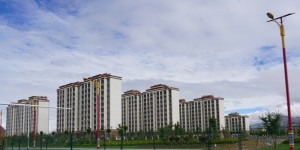 |
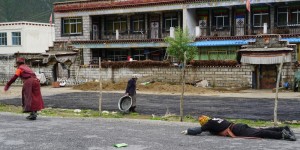 |
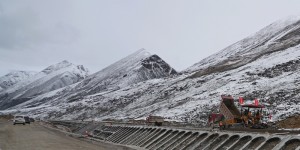 |
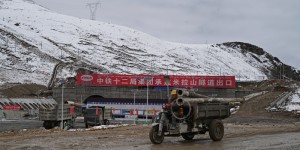 |
We had a brief stop at Rutou Village 日多乡where Kylie, Zangpo and I had delicious yak soup and local bread for lunch. We spent RMB80 for this wholesome meal. Brenda who cannot eat yak meat, had to wait for her lunch later. The scenery along the road to Mila Pass (5013m) which was still covered in snow was beautiful. A new tunnel through Mila Mountain is under construction. On completion, visitors will no longer need to go over Mila Pass to reach Nyingchi.
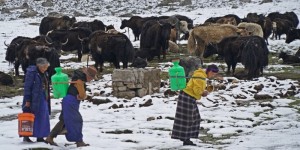 |
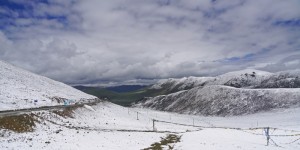 |
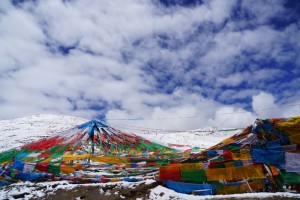 |
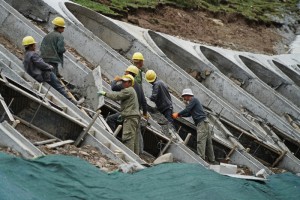 |
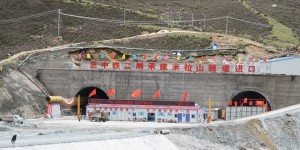 |
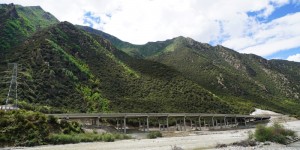 |
After the pass, we soon arrived in Songtou Village松多乡where Brenda had her lunch. On Zangpo’s suggestion, we proceeded to Basomtso for a night. Zangpo recommended a local guesthouse which did not have rooms with private facilities. We therefore decided tostay in the Himalaya Basomtso Hotel inside the Basomtso National Park. Kylie bargained with the sales lady of the hotel and got two rooms with lake view for RMB640. In addition, Zangpo could stay for free. We had to RMB110 to enter the park (a reduced entry fee of RMB60 and RMB50 for bus transfer though we drove to the hotel in our own vehicle).
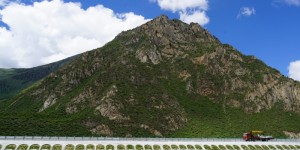 |
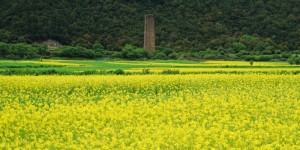 |
We had a long driving day. It was 8pm when we sat down for dinner. We paid RMB180 for a decent meal with four dishes. Just when we were about to leave, it started to rain heavily and the lights were suddenly gone. The first power failure on this trip! We did not get power back till 10pm. I shared a room with Kylie. Our room is lovely, modern, bright and clean. I had an excellent sleep!
June 21 Wednesday: Basomtso – Nyingchi130km
I did not have high expectations on my second visit to Basomtso. But it turned out to be the best part of the 6-day trip. As it was raining, Kylie and I did not bother to get up to watch sunrise. After an early breakfast, Zangpo accompanied Kylie and I to the Songtso Monastery错宗寺which has a 1300-year history.
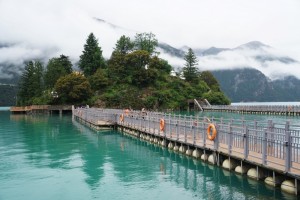 |
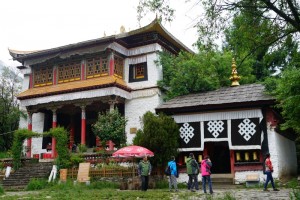 |
The lake surrounded by mountains looked enchanting in rain and morning mist like Chinese ink painting. The picturesque and historic monastery located on a small island belongs to the Nyima School. I discovered things I had not been told on my first visit. I founda thousand-year-old tree which exhibits a male sex organ. Close by is another tree with a female organ. As a result, some people come to pray for offspring. Inside the temple, I saw images of Padmasambhava.
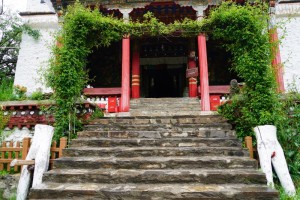 |
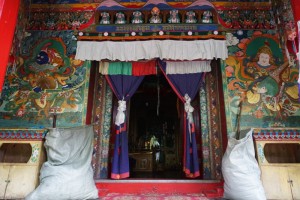 |
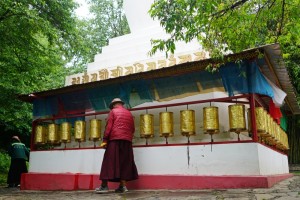 |
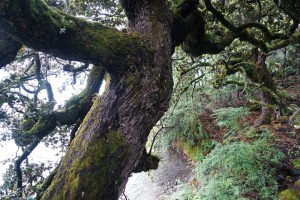 |
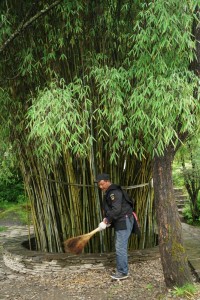 |
|
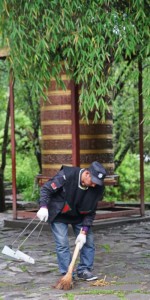 |
We returned to the hotel at 10:30am to pick up Brenda. After checking with other drivers, Zangpo discovered we could drive on a dirt road along the lake shore to CogaoVillage錯高村 next to the wetland at the head of the lake. Later I read from a travel magazine that this village is one of the ten most beautiful ancient villages in China.
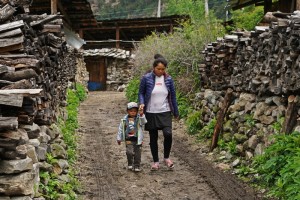 |
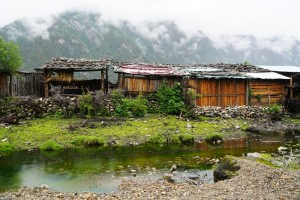 |
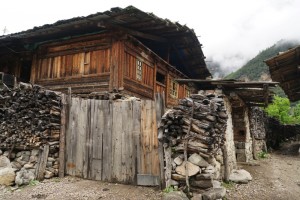 |
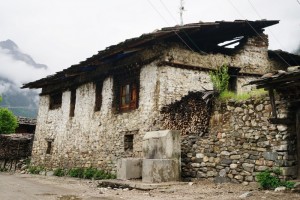 |
The village looks timeless with traditional wooden houses. Only a couple of houses belonging to the village head or important residents are built with stone and bricks. It’s tranquil untouched by modernisation or mass tourism. I watchedpigs roaming around, cows eating fresh grasses and horses drinking by the lake. I hope this village remains a secret and would not be ruined by mass tourism. I love to spend a night here if I ever return!
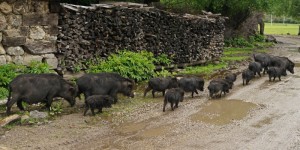 |
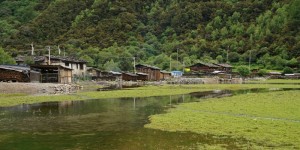 |
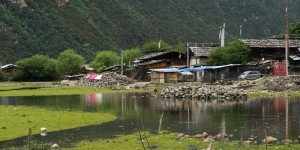 |
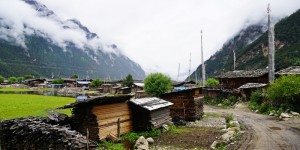 |
After spending an hour in Cogao Village, we took the same road back to Jieba Village 结巴村where a viewing pavilion has been built. The views of the lake, the village and patches of yellow-oil flowers are breathtaking. We did not have time to explore this village.
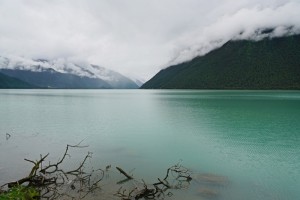 |
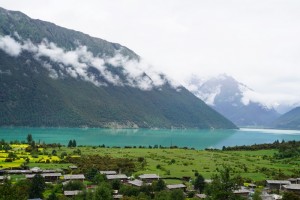 |
We left the park after 1pm and had lunch in a Sichuan restaurant in Pagqu Zhen after 2pm. We paid RMB150 for an excellent lunch. This small town is undergoing rapid changes with new roads, houses, restaurants and hotels under construction.
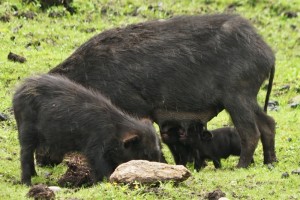 |
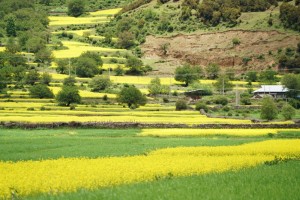 |
The next destination was theKadinggou Valley Scenic Area卞定沟風景區that I visited in 2011. Located 2980m above sea level, the area is picturesque with an iconic 200m-high Heavenly Buddha Waterfall and many remarkable rock formations. “Kading” in Tibetan means “the living paradise”. We paid an entry fee of RMB20. I was surprised to find over a dozen of tourist buses in the car park.
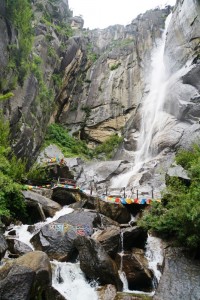 |
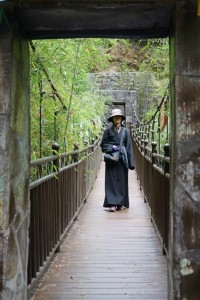 |
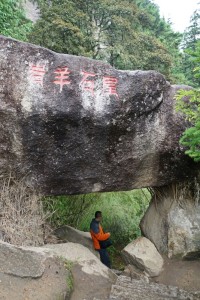 |
Since my last visit, some improvement works have been done: visitors follow a narrow walking path to reach the waterfall. Unfortunately, there were too many tourist. It was overcrowded and noisy. Fortunately, it had rained earlier in the day making the air fresh and the valley lovely green and moist. Hence, I had a lovely stroll for an hour and a half and made my way all the way to foot of the waterfall. I got wet.
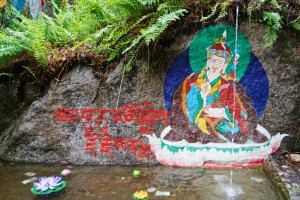 |
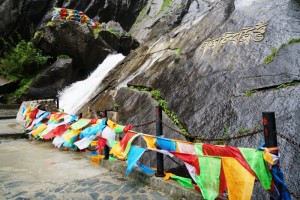 |
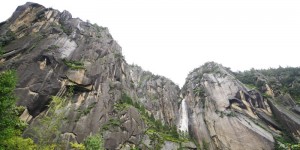 |
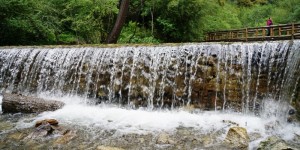 |
We took less than an hour to reach Nyingchi (2900m). The city has changed beyond recognition: it seems to have doubled in size. With squares, parks and open space, the city looks tidy and pleasant but without much Tibetan feel. We stayed at the 4-star Hongtian Hotel. Zangpo got us a good deal with two rooms for RMB600. As we had a late lunch, we were not hungry. We had dumplings in an eatery next door paying RMB90 for a meal for four.
June 22 Thursday: Nyingchi – Yarlung Zangbo Grand Canyon 雅魯藏布江– Suasong Village 索松村150km
Medog Nature Reserve covering a total area of 62, 620 hectares including valleys of the Yarlung Zangbo River’s great bend, is located at the southeastern border of China on the Qinghai — Tibet plateau. Set up in 1985, it is a less travelled virgin land where all the major vegetation types of the humid regions of the northern hemisphere can be seen- a microcosm of all the types of vegetation existing between the North Pole and China’s Hainan Island. The reserve houses over 3000 species of higher plants. Over 40 species of wild animals, comprising a quarter of the total number of animal species under key national protection list, have been found in the reserve.
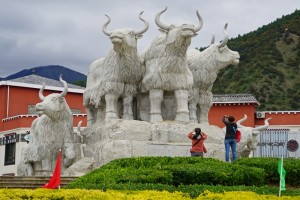 I turned 63 today and had a quiet day without any celebration. As we had received conflicting advice on whether we could visit Medog, we decided to go to the Frontier Control Officein person to get a final answer. Zangpo could not find the address online and took us to the Police station hoping to find out the address. After asking several people at the Police station, we still could not get an answer. As a result we spent over an hour driving in the city asking half a dozen of drivers and locals. We finally found the majestic new Frontier Control Office which is actually located near our hotel!
I turned 63 today and had a quiet day without any celebration. As we had received conflicting advice on whether we could visit Medog, we decided to go to the Frontier Control Officein person to get a final answer. Zangpo could not find the address online and took us to the Police station hoping to find out the address. After asking several people at the Police station, we still could not get an answer. As a result we spent over an hour driving in the city asking half a dozen of drivers and locals. We finally found the majestic new Frontier Control Office which is actually located near our hotel!
We found a mobile number on a notice board outside a waiting room at the gate. We called and spoke with an officer on the phone. He offered to come to meet us in the waiting room. At the end, we met two young officers in uniform who gave us clear answers. First, Medog is open to visitors and HK Chinese with permission can visit. Second, the application must be submitted and processed in Lhasa. This was the same for our visit to the Ngari Prefecture: our agent submitted our application on June 2 and we got the papers on June 3. We could have applied for permission for Medog on June 18 when we were back in Lhasa had we received correct information in time. I am impressed by the attitude of the officers who are polite and patient.
Brenda and I had also wasted some 40 minutes in changing HK$4500 into RMB. We went to ICBC only to be told that we had to go to the Bank of China. The staff however did not seem to know how to process the paper work. Brenda felt the exchange service today in Nyingchi is worse than those in Lhasa ten years ago. Perhaps, the Mainland expects all visitors to use plastic money!
As our last hope to visit Medog had vanished, we decided to continue our journey to Bome which Kylie had heard favourable remarks from the Beijing photographer whom we met in the Wenbu South Village. Zangpo suggested us spend the afternoon visiting the Yarlung Zangbo Grand Canyon before leaving for Bome the next day.
Yarlung Zangpo Grand Canyon Tourism Area.
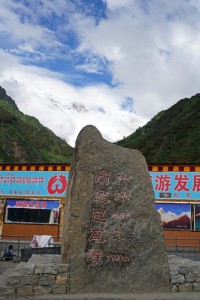 The 496km-long Yarlung Zangbo Grand Canyon with an average depth of 5,000 meters is the world’s deepest (it drops in places to 5,382m), longest, highest and narrowest one with stunning natural landscape. The Yarlung Zangbo River, the world’s highest river, makes a turn round Mt Namechakbarwa 南迦巴瓦峯 (7782m), the highest peak of east Tibet, thus forming the world’s largest canyon with an area of 64,300 km². The canyon is the only water channel from the Qinghai-Tibet Plateau to the Indian Ocean. Visitors enter the tourism area at Pai Zhen派镇.
The 496km-long Yarlung Zangbo Grand Canyon with an average depth of 5,000 meters is the world’s deepest (it drops in places to 5,382m), longest, highest and narrowest one with stunning natural landscape. The Yarlung Zangbo River, the world’s highest river, makes a turn round Mt Namechakbarwa 南迦巴瓦峯 (7782m), the highest peak of east Tibet, thus forming the world’s largest canyon with an area of 64,300 km². The canyon is the only water channel from the Qinghai-Tibet Plateau to the Indian Ocean. Visitors enter the tourism area at Pai Zhen派镇.
To get to Pai Zhen, we had to cross the Niyang River and then Yarlung Zangbo River before following a paved road on the right side of the Yarlung Zangbo River. We had two photo stops to look at the confluenceof Niyang River and Yarlung Zangbo River江河滙and a natural sand dune丹娘沙丘located on the other side of the Yarlung Zangbo River.
We paid RMB240 for this visit (a reduced entrance fee of RMB150 and RMB90 for transportation inside the area). After lunch, we waited for almost half an hour for a bus. It was about 3:45pm when we left the car park. We had a guide on the bus. I find the winding road dangerously narrow and can understand the reason for prohibiting outside vehicles to enter.
We had three photo stops. In the first stop, our guide showed us a 1300-year-old tree which was purported to have been planted by Songtsan Gampo. A short distance away is another ancient tree that has grown out of a gigantic rock.
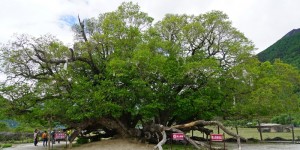 |
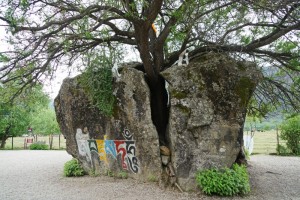 |
At the second stop, we followed a path to the river bank. The weather improved and we began to see part of the Namechakbarwa Mountain.
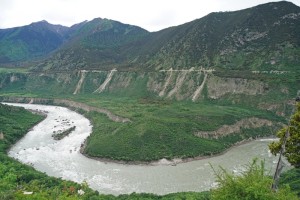 |
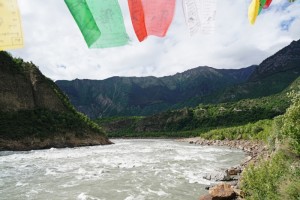 |
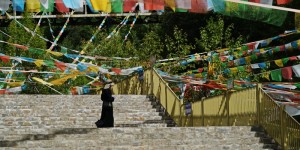 |
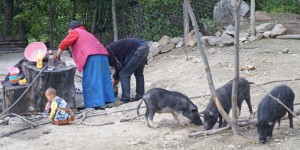 |
The last stop is the best spot on this short tour for viewing the highest peak of the Namechakbarwa Mountain. As the clouds were clearing up, we finally had a glimpse of the pointed peak for a few minutes. We were thrilled.
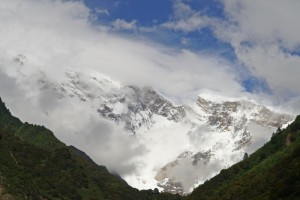 |
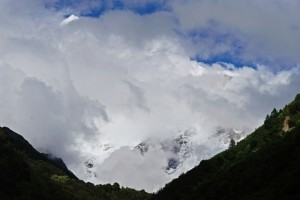 |
We were back to the car park at 6:15pm. I had a pleasant ride without any impression of the mighty canyon: I have not seen it really. The best shots of the canyon including the great bend and the landscape, are mostly taken near Medog.I think the best way to appreciate the canyon would be to hike or travel from Medog to Pai Zhen! I understand a road is being built and one day it may be possible to enter from one end and comes out at the other end of the canyon. I would be happy to come back if I could see the canyon in its entirety and spend some time in Medog. (The photo below shows the part of road we passed on the way to see Namechakbarwa Mountain which is visible on the left side)
We crossed the Yarlung Zangbo River and soon arrived at the small Suasong Village which is a favourite spot for photographers to take photos of the Namechakbarwa Mountain. We stayed in a family B&B and paid RMB260 for a twin room. It drizzled when we arrived. Once the sky cleared up, Kylie and I had a lovely walk in the field for an hour and a half. We watched three Tibetan ladies working in the field and took photos of birds and plants. We had a late dinner at 8pm and went to bed early.
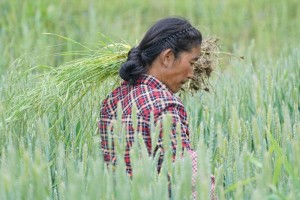 |
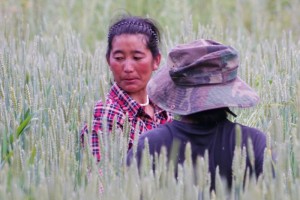 |
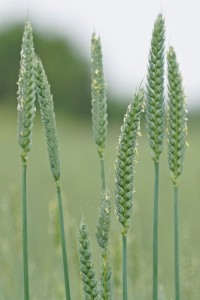 |
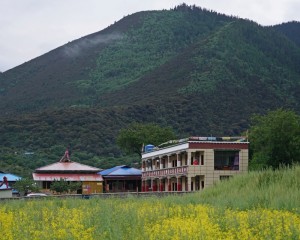 |
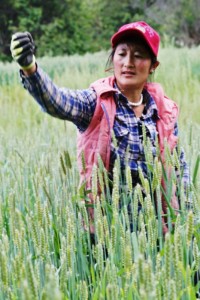 |


